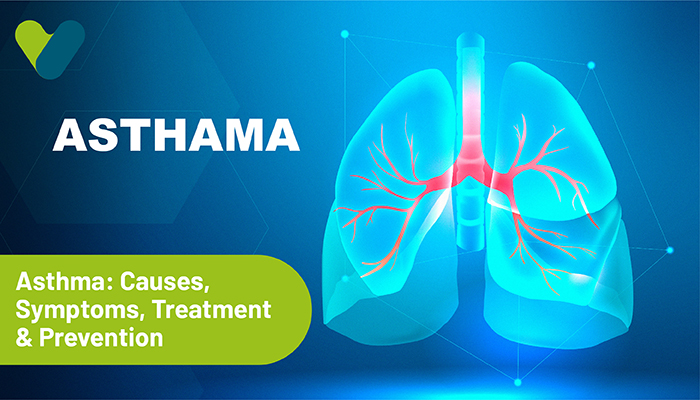Bronchial asthma, colloquially referred to as asthma, is a long-term, inflammatory lung disease that makes breathing difficult. It mainly targets the airways of the lungs making them narrow and swollen while also blocking them with mucus. Asthma is characterised by recurring symptoms such as coughing, wheezing, shortness of breath, chest pain or tightness and disturbed sleep cycles due to constant coughing and wheezing. Bronchospasms and reversible airflow obstruction are also characteristics of Asthma. Asthma is non-curable. However, the symptoms can be managed with medication facilitated by a medical device known as an inhaler. Such medication allows people with asthma to lead a normal and active life. Genetics and environmental causes, as well as lifestyle changes are linked to an increased risk of asthma. Also, the prevalence of asthma in children in higher in today’s age, most prominently due to compromised air quality. In India, the national burden of asthma is estimated at 17.3 million. Also, avoiding the warning signs of asthma can be life-threatening so people suffering from this ailment must take measures to manage it.
Types Of Asthma
Different triggers lead to different types of asthma. The following are the common types.- Adult-Onset Asthma You may have managed to avoid asthma triggers in your childhood. However, you can get exposed to triggers as an adult due to, air pollution, tobacco smoke, or upon getting a pet animal, among other things. Other viral infections can also unmask your asthma symptoms.
- Paediatric Asthma Paediatric asthma is essentially asthma in children. Children with asthma have inflamed and swollen lung airways. Common cold, pollen, flu, etc., can amplify asthma and make it difficult for children to perform daily activities.
- Allergic Asthma Allergens like dust, pollen, pet dander (dead skin from animal fur), mould, etc., can trigger asthma symptoms, and sometimes cause an asthma attack. Non-allergic asthma factors like viral respiratory infections, weather conditions, etc., can intensify an allergic asthma.
- Non-Allergic Asthma Non-allergic asthma is characterised by breathing problems brought by stress, sickness, extreme weather conditions, drugs, specific food additives, etc. These are triggers other than allergens, hence the name non-allergic asthma.
- Occupational Asthma If your occupation exposes you to chemical fumes or irritants in the air, you may be at risk of developing occupational asthma. Moreover, if you've already been diagnosed with asthma due to other causes, airborne irritants can make it worse.
- Exercise-Induced Bronchoconstriction (EIB) Physical activities can cause the airways to become narrow, leading to EIB. Loss of heat and water from the airways during exercise can cause EIB. Symptoms may occur within a few minutes of exercise. However, with proper treatment plan, you can continue physical activities.
- Asthma-COPD Overlap Syndrome (ACOS) ACOS is when you have both asthma and chronic obstructive pulmonary disease (COPD). Differentiating between asthma and COPD may be difficult due to similar symptoms. However, doctors may diagnose ACOS if there's persistent airflow obstruction.
- Seasonal Asthma Asthma that flares up during certain times of the year is referred to as seasonal asthma. The symptoms typically intensify during flu or cold season. Seasonal asthma can also be a type of allergic asthma where symptoms are triggered due to allergens appearing at different times of the year.
- Nocturnal Asthma Asthma where symptoms aggravate during the night is nocturnal asthma. Triggers like heartburn, dust mites, pet dander, etc., are the known causes of nocturnal asthma. Your body's natural sleep cycle may also impact this type of asthma.
What Triggers Asthma?
The exact cause of asthma remains unclear. However, genetics and environmental factors play a major role. If you have inflamed airways, you may be sensitive to things that tend to not bother other people. These factors are known as triggers. The following are the common asthma triggers:- Tobacco Smoke Smoke from tobacco consumption is extremely unhealthy if you have asthma. Second-hand smoke, i.e., smoke created by another smoker and inhaled by you, can also trigger an asthma attack.
- Allergies If you inhale substances that you are allergic to, you may experience symptoms of asthma. Common allergens include dust particles, pollen, mould, etc.
- Airborne Irritants Air pollutants from wood fires, charcoal grills, motor exhausts, etc., can lead to inflamed airways. Fumes and vapours from chemicals like paint, perfumes, scented candles or soaps can trigger asthma.
- Physical Activity Breathing harder than usual can lead to an asthma attack. You typically tend to breathe hard when you exercise, especially in cold air.
- Weather Sudden weather or temperature changes may bring on an asthma episode. Intense weather like lightning from thunderstorms can break pollen. Strong winds can spread these particles.
- Strong Emotions Your breathing changes when you experience strong emotions like anger, excitement, laughter, fear, crying, etc. Stress can also worsen your asthma.
- Pets Pet dander, urine or proteins in their saliva can aggravate your asthma symptoms. The symptom may get worse for children.
- Other Health Conditions Comorbid conditions like allergic bronchopulmonary aspergillosis (ABPA), obstructive sleep apnoea, anaphylaxis, obesity, nasal polyps, rhinitis, and respiratory infections can trigger asthma.
- Aspirin Non-steroidal anti-inflammatory drugs (NSAIDs) like aspirin, ibuprofen, naproxen, etc., can aggravate asthma symptoms. Asthma from aspirin consumption can cause aspirin-exacerbated respiratory disease (AERD).
A Brief Pathophysiology Of Asthma
Asthma affects the lungs. The lungs are air-filled organs through which inhaled air passes. The windpipe (trachea) passes air to the lungs via tubular branches called bronchi. The bronchi is further divided into smaller branches called bronchioles. These bronchioles form clusters of microscopic air sacs called alveoli, facilitating the absorption of oxygen from the air into the blood. The carbon dioxide you exhale travels from the blood to the alveoli. The respiratory system is made up of two zones. The conducting zone extends from the nose to the bronchioles. The respiratory zone extends from the alveolar duct to the alveoli, i.e., where gas exchange takes place. Under normal circumstances, when you inhale, the lungs expand, and they contract when you exhale. However, with asthma, the normal physiology of lungs gets disrupted due to inflammation, causing bronchioles' radius to decrease. As such, you need to put more effort to breathe. Asthma exacerbation takes place in two phases – early phase and late phase. In the early phase, the body produces immunoglobin E (IgE) antibodies in response to aforementioned triggers. When you inhale a risk factor, the antibodies localise to bronchioles causing them to tighten. The interleukins produced by the white blood cells attribute to fibrosis and hyperplasia. The late phase commences after a few hours of the early phase. At this point, most of the antibodies move to the lungs leading to bronchoconstriction and inflammation. This, in turn, causes intermittent airflow obstruction. While there is no cure for asthma, doctors may provide medication to treat the triggered airways and prevent episodes of asthma. Depending on the severity of asthma symptoms, this breathing disorder can be classified into the following types.- Intermittent With intermittent asthma, the symptoms are mild, generally do not interfere with daily activities, and may last for one or two days a week.
- Mild Persistent You may experience symptoms for more than twice a week. Symptoms may also last for not more than four nights in a month.
- Moderate Persistent In this case, the symptoms occur everyday during the day and at least once a night every week.
- Severe Severe asthma inhibits daily activities because symptoms occur daily and most nights.
Treatment for Asthma
Your doctor may recommend quick relief medications, long-term control medications, and treatments based on your age, triggers, and type of asthma. Treatment options include:- Bronchodilators Bronchodilators are medication that allow you to breathe easily. They relax lung muscles and widen the bronchi. Bronchodilators are quick-relief treatments that work within minutes. They can be injected or administered orally. The most common way to consume bronchodilators is through inhalers or nebulisers. A metered-dosed inhaler (MDI) uses pressure to push the medication out of the inhaler and into your body through your mouth. Nebulisers form a mist of medication, delivered to your lungs via a tube or mask that fits over your mouth and nose. Doctors may also recommend dry powder inhalers (DPIs) that require fast inhalation. You can use an inhaler before exercising to prevent an asthma attack episode while you work out. Overuse of inhalers, however, is a warning sign of severe asthma and you may need a different treatment plan.
- Long-term Medications Long-term medication includes anti-inflammatories, long-acting bronchodilators and anticholinergics. Anti-inflammatories like corticosteroids reduce swelling and mucus production while anticholinergics prevent muscle tightening. Doctors may prescribe long-acting bronchodilators twice a day in tandem with other inhaled steroids.
- Biologics A biologic is a type of medication made from living organism cells. These cells are modified to target specific areas in humans. In case of asthma, the targets are the antibodies produced by the immune system. Biologics are used when standard medication fails to alleviate asthma symptoms. Based on your symptoms, the doctors can administer five approved biologics – omalizumab, reslizumab, mepolizumab, benralizumab and dupilumab. The biologics must be taken under a doctor's supervision through a subcutaneous injection or intravenous infusion.
- Bronchial Thermoplasty Bronchial thermoplasty is a treatment for severe asthma. The treatment uses electrodes that heat the bronchi. This helps to reduce the surrounding muscles' size and prevents tightening. A pulmonologist (lung doctor) performs this procedure across multiple sessions. Different sessions may involve the treatment of different sections of the lung. Only adults with severe asthma are allowed to undergo a bronchial thermoplasty treatment. During this treatment, the pulmonologist inserts a bronchoscope (a long flexible tube) through your mouth or nose into your lungs. The pulmonologist then inserts a catheter into the lungs through the bronchoscope. The catheter delivers heat to smooth muscles in the lungs to prevent them from tightening. This treatment may reduce the severity and frequency of asthma attacks. However, you'll need to take lower steroid doses indefinitely.
How To Prevent And Manage Asthma?
The following are methods to help you manage asthma symptoms:- Steer Clear Of Allergens Allergens like dust, mould, chemicals, fumes, intense smells from perfumes and disinfectants can cause breathing problems. It is best to avoid or at least reduce your exposure to these allergens, ideally by wearing a mask.
- Get Allergy Injections You can desensitising your immune system through allergen immunotherapy, i.e., by taking allergy injections can alter the immune system's response.
- Quit Smoking Tobacco smoke is a severe airborne irritant. It triggers asthma while also causing heart diseases, cancer, etc. To manage your asthma symptoms, you can benefit from quitting tobacco.
- Exercise Regularly While physical activity is generally a trigger for asthma, moderate but regular exercise may reduce risks pertaining to breathing complications.
- Manage Stress Stress can trigger asthma and make it difficult to prevent asthma episodes. Regular meditation, a balanced diet, and therapy can help manage stress.
- Change Bedsheets Frequently Dust mite and pollen can deposit on bedsheets, sofa, carpets, curtains, etc. Ensure you change your bedsheets and clean fabrics frequently.
- Treat Heartburn Heartburns from acid reflux can damage lung airways and intensify your asthma symptoms. You may also need treatment for gastroesophageal reflux disease (GERD) to prevent inflammation of the lungs.


